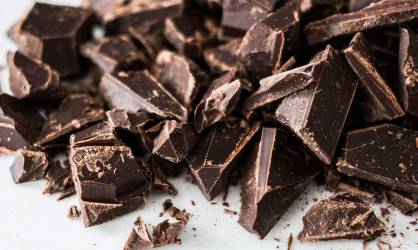Oil:
-
Brent crude oil is scoring a second consecutive week of a stronger pullback. The area tested is around $90, which coincides with the 100-week average. Key support for Brent is around $88-89 per barrel
-
On WTI oil, last week was a clear doji candle and a pullback this week. The correction in the oil market is supported by a strong dollar and uncertainty about China
-
For August, global oil inventories fell by more than 70 million brk. However, oil is showing a clear warning signal by looking at the futures curve. October-November, October23-October24 and December23-December24 spreads have reached extremely high levels
- JP Morgan expects a price of $100 per barrel and does not rule out a short-term rally to $150 per barrel
 Spreads for WTI crude suggest overbought conditions, although prices still remain clearly below $100 per barrel. Source: Bloomberg Finance LP, XTB
Spreads for WTI crude suggest overbought conditions, although prices still remain clearly below $100 per barrel. Source: Bloomberg Finance LP, XTB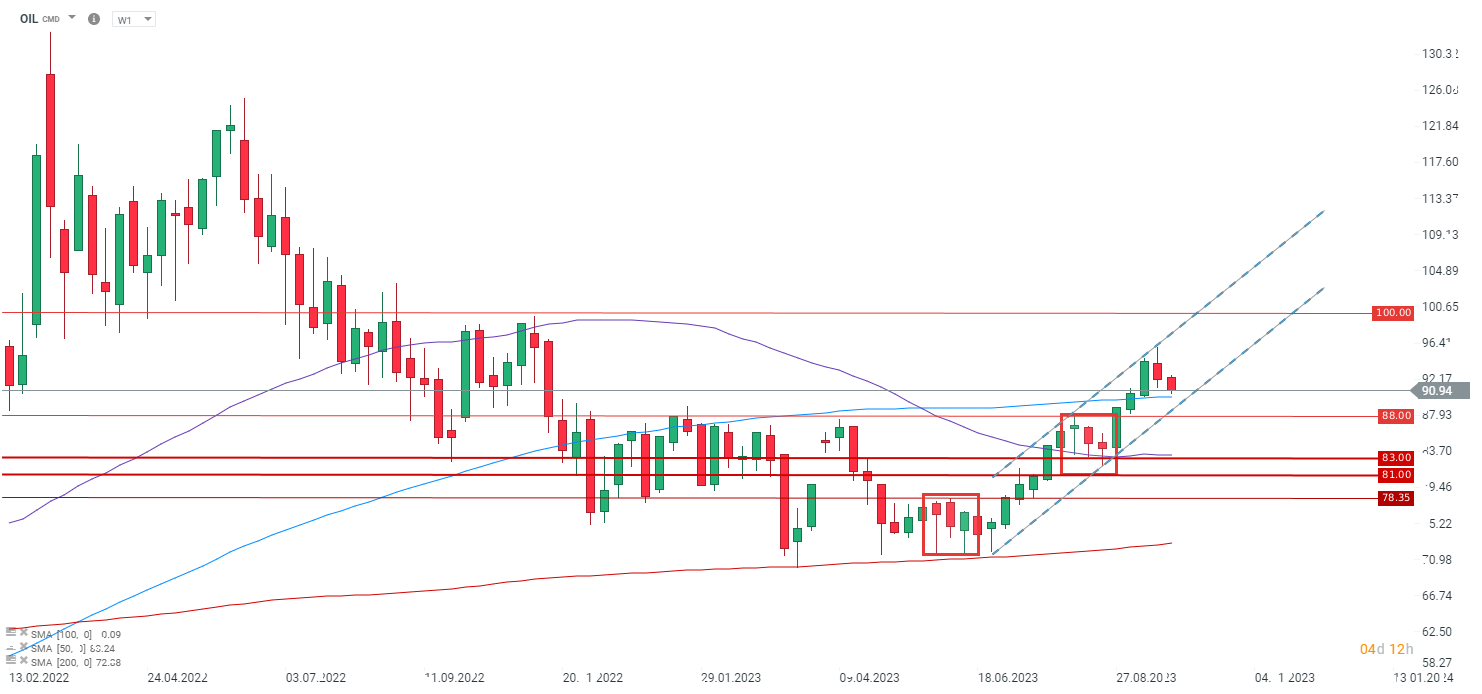 Brent crude oil is falling for the second week in a row and is trying on a test of the 100-week average. After that, the key support is $88 per barrel stemming from the local peaks of January, April and August. Source: xStation5
Brent crude oil is falling for the second week in a row and is trying on a test of the 100-week average. After that, the key support is $88 per barrel stemming from the local peaks of January, April and August. Source: xStation5
Cocoa:
- The price of cocoa has reached its highest level in 46 years due to an expected sizable deficit in the 2023/2024 season. This will be the third consecutive deficit of the season
- During the summer season, key producers such as Côte d'Ivoire and Ghana experienced heavy rains and flooding that led to cocoa tree diseases.
- Côte d'Ivoire and Ghana account for more than 2/3 of global production. In contrast, all West African countries already account for 75% of world production, so weather problems in the region are very much in perspective for production
- A wet summer on Africa's west coast is to be followed by an extended period of drought associated with the El Nino phenomenon, which could adversely affect harvests for the season proper, which begins October 1. The situation is worst in Ghana, slightly better in Côte d'Ivoire
- ICCO indicates that Ghana's cocoa production is expected to reach 750,000 tons in the 2022/2023 season currently still underway, although trade data indicates that production (supplies) may not have exceeded 650,000 tons, which would be a 13-year low in production
- Global cocoa processing performance has been strong in recent quarters, but there are also warning signs indicating that high prices may be curbing demand.
- In Asia (the market likely to grow strongest in the next few years), we have a decline in cocoa throughput in Q2 to 214,000 tons, or -6.5% y/y. Cocoa throughput in Asia, Europe and North America was one of the lowest in years, although this was also partly due to lower cocoa availability
- Just before the start of the season proper, farmers in Côte d'Ivoire indicate the condition of the trees is relatively good, but indicate that harvesting will start later due to earlier flooding
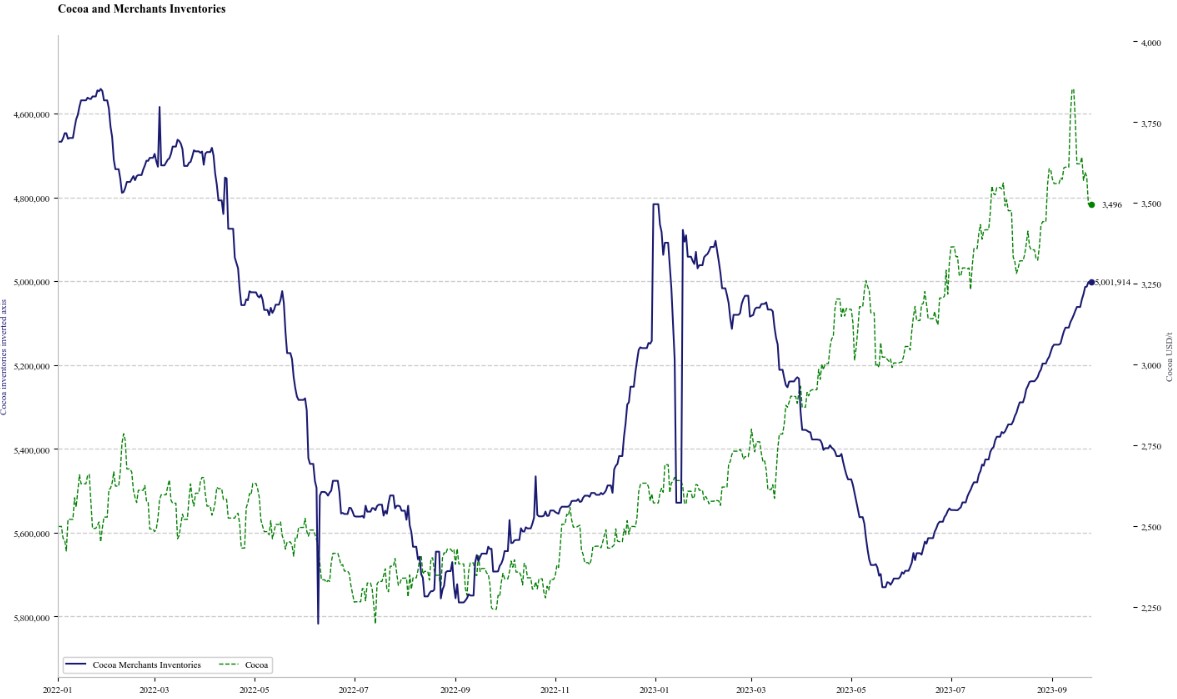 Cocoa stocks (tracked by ICE) are falling sharply (inverted axis). Source: Bloomberg Finance LP, XTB
Cocoa stocks (tracked by ICE) are falling sharply (inverted axis). Source: Bloomberg Finance LP, XTB
 Historical cocoa price action. Note the last chart in the middle row, which shows the maximum, average and minimum price movements since the beginning of the year over the long term. Source: Bloomberg Finance LP, XTB
Historical cocoa price action. Note the last chart in the middle row, which shows the maximum, average and minimum price movements since the beginning of the year over the long term. Source: Bloomberg Finance LP, XTB
Average price action of cocoa in the last 5 years and in the long term and in 2023 (red line). Source: Bloomberg Finance LP, XTB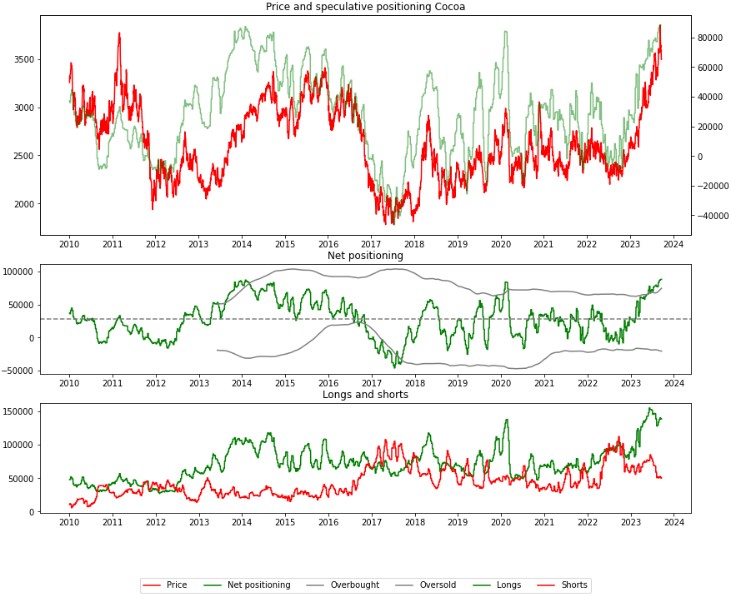
The number of long positions on cocoa remains extremely high. "Overbought" is similar to 2013 or 2019. Source: Bloomberg Finance LP, XTB COCOA is down about 7% from near 50-year highs. Key support is near 3400, and the right season is about to begin, which could theoretically favor profit taking. In addition, a weak pound could also be a factor limiting gains. On the other hand, a sizable deficit in the market should favor keeping prices high for the rest of this year. If stocks begin to rise, however, this could be a signal indicating a larger price retreat.
COCOA is down about 7% from near 50-year highs. Key support is near 3400, and the right season is about to begin, which could theoretically favor profit taking. In addition, a weak pound could also be a factor limiting gains. On the other hand, a sizable deficit in the market should favor keeping prices high for the rest of this year. If stocks begin to rise, however, this could be a signal indicating a larger price retreat.
Gold:
- Gold remains relatively high, despite a strong rise in US yields. 10-year yields reach 16-year highs above the 4.5% level
- UBS points out that gold remains at high levels thanks to demand from central banks, which are reducing the share of reserves in the dollar and channeling those reserves into other assets like gold
- High yields and the possibility of another hike by the Fed are causing further outflows from gold ETFs, which continue to sell off the metal from vaults
- At current levels of yields, gold hovered around $600 per ounce in 2006. However, yields behaved very similarly (they rose strongly after the 2002/2003 lows). Of course, at that time it was just before strong interest rate cuts - now we are unlikely to expect cuts until at least the middle of next year.
- On the other hand, 10-year yields are already just 100 basis points away from the level of short-term rates at 5.5%
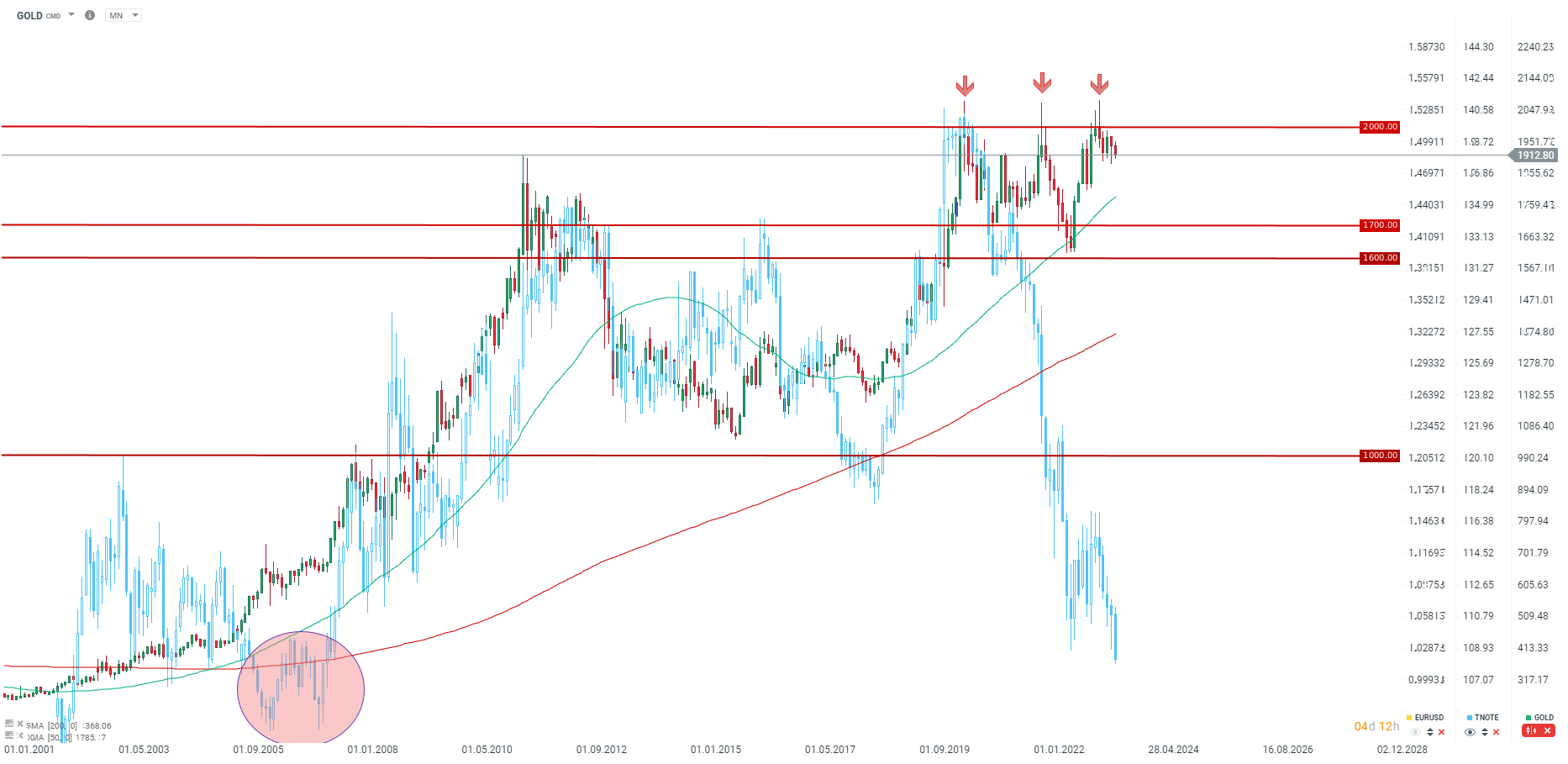 Key support at $1,900 per ounce is held. However, if yields were to head to 5%, then gold could fall as low as $1,800-1820 per ounce, where the local lows of April and the 50-month average are located. Source: xStation5
Key support at $1,900 per ounce is held. However, if yields were to head to 5%, then gold could fall as low as $1,800-1820 per ounce, where the local lows of April and the 50-month average are located. Source: xStation5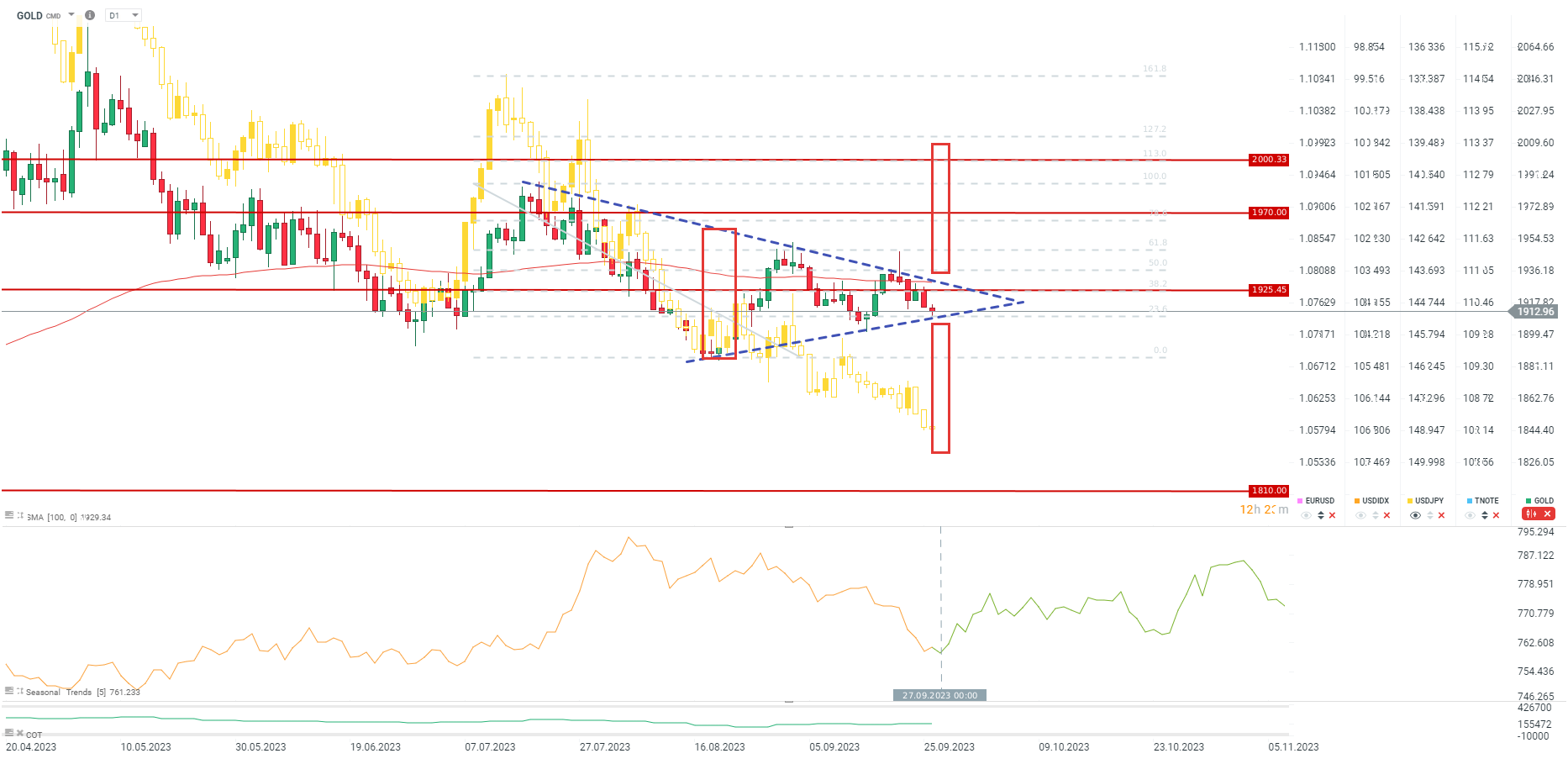
Looking at a slightly shorter term, GOLD is testing key support in the form of the lower limit of the triangle formation. The 5-year seasonality indicates a potential rebound in the near term. For that, however, we would have to see a drop in yields and a weakening of the dollar, which is currently unlikely. Source: xStation5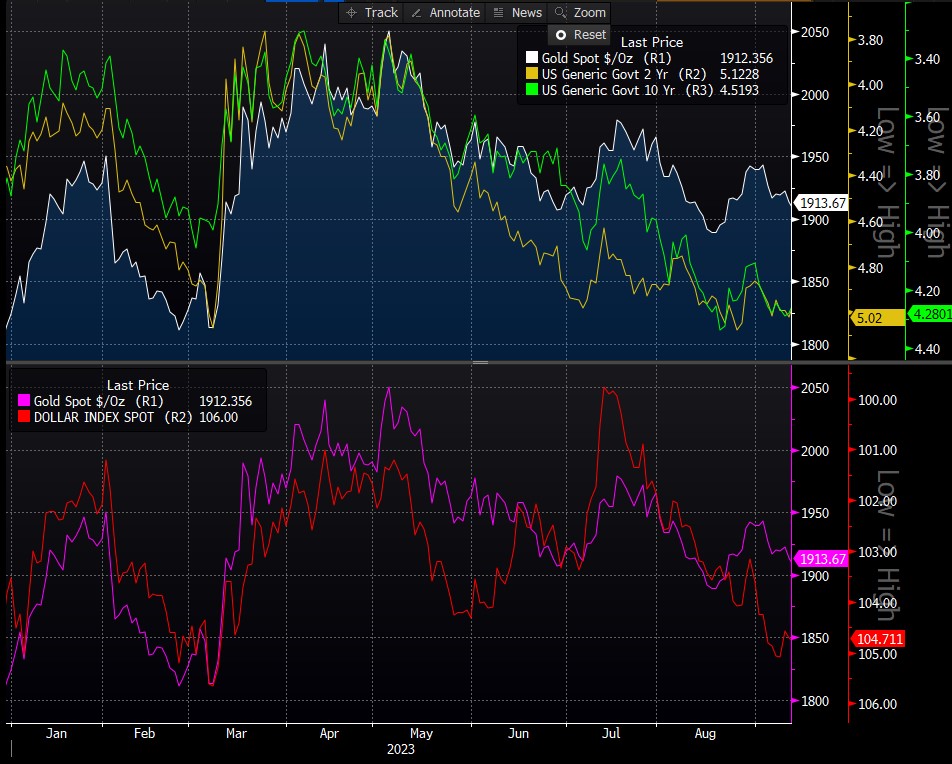
The 2-year yields are at similar levels as in March. On the other hand, 10-year yields are at 16-year highs, which for now does not give a positive picture for gold. On the other hand, physical demand from central banks that are diversifying their reserves remains high. Source: Bloomberg Finance LP
Wheat:
- Russia's renewed focus on attacks on Ukraine's export infrastructure, pushing prices up modestly from about a 2-year low
- It seems that we should not expect a return to negotiations on an agreement on Ukrainian agricultural exports in the coming weeks
- On the other hand, Kiev is said to be preparing to open a new shipping channel across the Black Sea
- The U.S. wheat harvest is essentially complete. Sowing of winter wheat is underway. Currently 26% of the planned acreage is sown (up from 15% according to previous data, but this is lower than 30% a year ago)
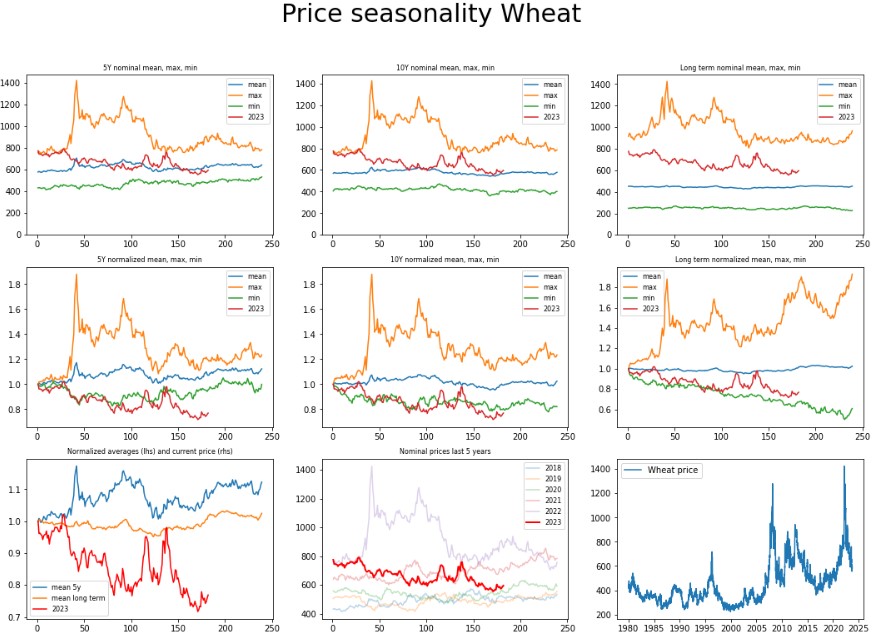 The behavior of wheat prices this year is almost the worst ever. The loss since the beginning of the year is more than 20%. Theoretically, the average price behavior over the last 5 years and over the long term points to potential increases at the end of the year, but on the other hand, the current price behavior resembles the "worst" at least since 1980. Source: Bloomberg Finance LP, XTB
The behavior of wheat prices this year is almost the worst ever. The loss since the beginning of the year is more than 20%. Theoretically, the average price behavior over the last 5 years and over the long term points to potential increases at the end of the year, but on the other hand, the current price behavior resembles the "worst" at least since 1980. Source: Bloomberg Finance LP, XTB
WHEAT is rebounding for the 3rd session in a row due to uncertainty over supplies from Ukraine. On the other hand, the market is saturated with Russian wheat, which may favor further declines in the short term. If the downward trend line is broken, then the price could try to reach the area of 615-620 cents per bushel where there is important short-term resistance. Source: xStation5
Morning wrap (31.10.2025)
Daily Summary: ECB, FOMC and MAG7 - mixed signals and risk aversion
BREAKING: EIA gas inventories change slightly above expectations. NATGAS increase after EIA data 📌
Breaking: Update on Soybean - China to Buy 12 mt Soy This Year
